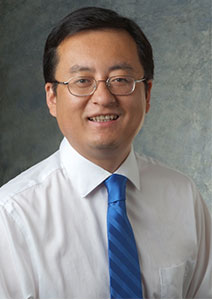U.S. Department of Energy awards newest ‘Industrial Assessment Center’ to Case Western Reserve University, covering parts of Ohio, Michigan and Western Pennsylvania
Case Western Reserve University will soon offer free energy-efficiency assessments to qualifying manufacturing companies and water treatment plants in an industrial belt spanning parts of three states—including Northeast Ohio, some of the lower peninsula of Michigan and Western Pennsylvania.
The energy assessments could save up to 15-20% on energy costs at the average industrial plant, said Chris Yuan, director of the new U.S. Department of Energy (DOE) Industrial Assessment Center at Case Western Reserve.
More information about the center, including details on how to apply for a free assessment, can be found through its online portal.
Yuan, a professor of mechanical and aerospace engineering at the Case School of Engineering and director of the university’s Laboratory for Sustainable Energy Manufacturing, was awarded a three-year, $510,000 grant to establish the assessment center.

The DOE now has about 30 similar centers at universities across the country, but until now, the closest ones to the Cleveland area were in Dayton and Morgantown, West Virginia, Yuan said. He said the new center is hiring university students to help with the assessments. The center will help local manufacturers and water plants to reduce their energy use and support their efforts to cut utility costs.
“This is a great opportunity for the industries of this region to save on their utility costs, increase their profit margin and cut their contribution to greenhouse gas emissions,” Yuan said. “We will also be training the next generation of engineers on how to be the most efficient in many different situations.”
Yuan had established a center at the University of Wisconsin-Milwaukee from 2011-16 and renewed the center for 2016-21, before arriving at Case Western Reserve.
“The U.S. Department of Energy’s Industrial Assessment Center has been helping companies across the country for over 40 years to reduce their energy bills and optimize performance,” said Grant Goodrich, executive director of the Great Lakes Energy Institute at Case Western Reserve. “This is an exciting opportunity for CWRU to share our researchers’ expertise with companies and manufacturers across Northern Ohio and the Lake Erie region.”
How it works
Faculty and students at the center will work with a variety of manufacturers and water plants within 150 miles of the university. Generally, the plants they will assess have:
- Gross annual sales of less than $100 million;
- Fewer than 500 employees; and
- Spend more than $100,000 (but less than $2.5 million) on annual utility costs.
Interested companies may apply online to obtain a free energy efficiency and productivity assessment for a manufacturing facility or water treatment plant.
The center expects to execute at least one assessment per month, Goodrich said. At the end of the three-year grant, the DOE requires the center to compete for renewal.
Assessments are free to the companies and will be conducted by one or two faculty members and a team of students. The in-person part of the assessment in a plant usually lasts a full work day. Six Case School of Engineering faculty members are involved in the center.
The Industrial Assessment Center also expects to train dozens of students. The students would conduct the assessments under the guidance of the faculty and perform extensive technical work on the energy data collection, process modeling, result verification and reporting-writing activities.
Simple solutions pay off
Yuan said it’s surprising at first how many companies aren’t thinking about how to save money on energy.
“It is until you remember that they are often focused on producing their products,” he said. “They don’t always see how being efficient will make them more profitable, but our years of experience and study have taught us how to help them.”
One example, Yuan said, is that electric utilities charge companies a rate for an entire month based on their peak demand. To remedy that, the company can strive to schedule its production in a way that smooths out its peak use of electricity—not allowing the peak usage to drive up their costs.
Sometimes, he said, companies can instead rely on backup battery power to reduce peak demand charges. “Alleviating peak demand charges alone can result in savings of thousands of dollars a month,” he said.
Another common example is to assess and improve the combustion efficiency of large natural gas burners involved in either boilers or furnaces directly heating the production process or building space-through supplying appropriate mixture of fuel and oxygen.
“This is an effective way to reduce the natural gas consumption and greenhouse gas emissions. We can test for it and help improve it,” he said.
For more information, contact Mike Scott at mike.scott@case.edu.
This article was originally published Dec. 16, 2019.

